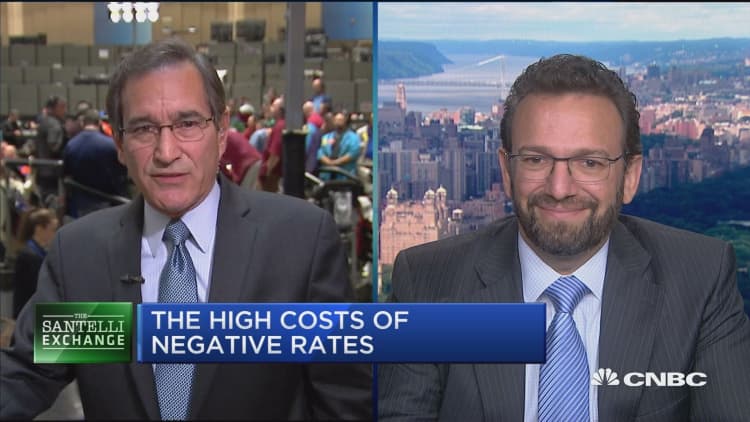Home mortgages and corporate borrowing just got a little more expensive this week, courtesy of central banks in Europe and Japan.
While Wall Street is focused on whether the Federal Reserve will raise interest rates or not, rising yields in the long end of the U.S. bond market in recent sessions have been directly related to the negative yield and bond-buying policies of both the European Central Bank and the Bank of Japan.
Neither institution has taken any new action, but that is the point. This is a bond market that has become fairly complacent that new and bigger central bank easing programs will keep supplying the world with easy money at super-low rates.
Now, yields have risen suddenly to levels last seen in June, and investors are concerned that holding securities at still very low yields, and super-high prices, makes them vulnerable when central banks take their foot off the quantitative easing pedal. Quantitative easing, used by central banks around the world, is the purchase of securities in an effort to drive investors into other riskier securities and keep rates low.

European Central Bank President Mario Draghi sparked a ramp up in global interest rates last week, when he neither extended the ECB's quantitative easing, or bond-buying program, nor added new securities to it, as expected in the markets. The selling picked up when news reports appeared this week suggesting the Bank of Japan will no longer buy long-dated securities in its QE program.
"I think there's a rethinking going on about the benefits and costs of bringing long-term rates as low as they did," said Robert Sinche, chief global strategist at Amherst Pierpont Securities. Some of the concerns have been that central banks crowded out other buyers of long-term debt, and that has particularly hurt pensions, insurance companies and other financial institutions, who need to hold long-dated securities.
The U.S. 30-year yield rose to a high of 2.50 percent on Thursday, the highest level since June 24. The 10-year yield climbed in the last several days to a high of 1.75 percent, a level last seen before the British vote to leave the European Union in June. Both the BOJ and ECB have instituted negative yields but yields at the long end have been moving higher. The yield on the German 10-year, for instance is no longer negative, and the negative-yielding Japanese 10-year has been rising toward zero.
U.S. home mortgages are tied to the 10-year Treasury yield, and the 30-year conventional mortgage rate has ticked up slightly by about an eighth of a point to roughly 3.5 percent.
So far, these moves aren't enough to jolt the stock market, but if the easing programs were curbed or rates rose dramatically higher, they could.
"In many respects, the European Central Bank and the Bank of Japan have a greater influence over our market than the Fed does. You're seeing somewhat of a pause in European Central Bank and Bank of Japan policy and that's impacting the global bond market," said Jack Ablin, CIO of BMO Private Bank. "If you get any kind of pullback. ... The European Central Bank program ends in March 2017. If there's any indication that's not going to be extended, that will impact the stock market."
Ablin said low European rates have made it possible for U.S. companies to not only issue cheaper debt at home but also in Europe.
Sinche said the idea of negative yields is also under scrutiny. "There was a belief that would somehow generate this resurgence of investment, and there's absolutely no sign of it. The negatives of very low long-term rates has been showing up in things like excessive risk appetite," he said. Sinche also said it seems to be increasing the savings rate rather than decreasing it, as investors look for a bigger capital base on which to make returns.
Selling in the bond market could continue, as the BOJ meets next week and now there's more speculations about its potential actions than those of the Fed. Both central banks meet Tuesday and Wednesday. While the Fed is not seen raising rates, there's speculation the BOJ could tweak its easing program and reveal findings of its review of its own policies.
"There's talk that even if the BOJ continues to purchase 80 trillion [yen] a year that they're really going to bias that toward the short end of the yield curve, and I think there's also some sense coming out of the European markets. The Europeans have a bigger problem. They can't buy debt with yields less than the deposit rate, which is minus 40 basis points," said Sinche. He said that means the ECB can't buy much of the debt of Germany, the biggest economy in Europe, with a duration of less than six years.
"The last two years especially, the markets have been operating on the nuances coming out of the overseas market, more than anything locally driven," said George Goncalves, head of rate strategy at Nomura. "It worked in one direction in terms of driving rates to super-low levels, back in July and it works in the opposite direction as well."
The ripples in the bond market could continue, but they are not seen yet as the start of a violent shakeout that slams stocks. Bond yields fell sharply and stayed low for weeks after central banks signaled they would make sure the U.K. vote to leave the EU would not harm the economy.
"I think it could have gotten violent if the Fed hikes in September. That would now come as a great surprise given the data," said Sinche. August nonfarm payrolls were weaker than expected but so are other data, like Thursday's August retail sales, down 0.3 percent.
Goncalves said the central banks are not stepping away from their programs, they are tweaking them. "You have almost $200 billion a month and a captive buyer. That hasn't changed. So what's new is just that we're not learning they want to do more," he said.
"It shows in the first place that bonds were overvalued and disconnected from fundamentals," he said.
Sinche said the market is just moving toward a more normal rate. The 10-year was at 1.70 Thursday, but it had reached a high of 1.98 percent earlier this year and averaged 1.83 percent in the months between March and May.
"The problem is the market is accustomed to seeing bold easing programs," said Goncalves. "Basically we're kind of toward the end of the line when it comes to central banks being able to move the broader risk markets and it's going to come back to fundamentals."
Goncalves does not expect the current sell-off to get out of hand though it could continue, and central banks will continue to rein in the short end of the curve.
It would become problematic, "if they were to stop and their economies aren't strong enough and even if they are, who knows. This is not the beginning of a taper tantrum yet, because they're still buying bonds, but if they were ever going to stop buying bonds it's going to reprice. This isn't what we're seeing now. There's uncertainty in the air, the ECB didn't do anything last week. There's questions about what the Bank of Japan could do next week," he said. But as for the current move up in yields, "it's healthy."





